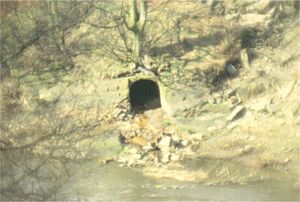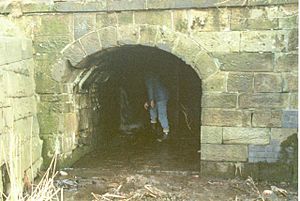Matthew Fletcher (mine owner and engineer) facts for kids
Matthew Fletcher was an important mine owner and engineer in Lancashire, England. He lived from 1731 (or 1733) to 1808. He helped change how coal was mined and moved in his time.
Contents
A Family of Miners
Matthew Fletcher came from a family of coal miners and mine owners. His father, Jacob Fletcher, owned small coal mines near Bolton. Matthew was one of four sons. His family had been involved in mining for a long time.
Solving Problems at Wet Earth Colliery
One of Matthew Fletcher's first big projects was at Wet Earth Colliery in Clifton. This was the first deep coal mine in the Irwell Valley. The mine had a huge problem: it kept filling with water from the River Irwell. This made it very hard to get the coal out.
The mine owner, John Heathcote, asked Matthew Fletcher for help. They tried to find a way to remove the water, but it was very difficult. In 1750, the mine had to close because of the flooding.
Then, a famous canal engineer named James Brindley got involved. He was known for building canals like the Bridgewater Canal. Brindley suggested using a special water-powered pump. The problem was there wasn't enough flowing water at the mine to power it.
Between 1750 and 1756, Matthew Fletcher took over ownership of Wet Earth Colliery. After reopening the mine, he dug a new shaft called Gal Pit. This shaft was about 48.5 meters deep and 4 meters wide. It was named after the small ponies used to pull coal.
Developing More Mines
By 1760, Fletcher had opened another mine called Botany Bay Colliery. It was about 1.6 kilometers east of Wet Earth Colliery. He extended Brindley's water channel to this new mine. He also added a second waterwheel to help lift coal out of the shaft.
Fletcher developed several other coal mines in the area. These included Clifton Hall Colliery and Ringley Colliery. He also opened Spindle Point Colliery and Robin Hood Colliery. He even built a house for himself, Clifton House, near the mine. It was taken down in 1965.
Fletcher's Canal and Connecting to Other Canals
In 1790, Fletcher made the water channel between Wet Earth and Botany Bay Collieries wider and deeper. This became a 2.4-kilometer section of canal, which opened in 1791. It was known as Fletcher's Canal. At first, it only helped move coal to a nearby loading area.
Later, in 1796, the Manchester, Bolton and Bury Canal opened. This canal connected to Salford. The Clifton Aqueduct carried this canal over the River Irwell. It took five more years for Fletcher's Canal to connect to the main canal. There were disagreements about water rights.
Fletcher had built a lock to connect his canal, but it didn't quite fit the water level of the Manchester, Bolton and Bury Canal. An engineer named Benjamin Outram suggested building another lock. Instead, Fletcher made his lock much bigger. It was about 27.4 meters long and 6.4 meters wide. This large lock could hold three narrow boats side by side.
Once the connection opened in 1801, Fletcher could send coal to Manchester, which was about 9.7 kilometers away. Following the idea of underground canals used in other mines, Fletcher also dug short underground tunnels at his collieries. These tunnels allowed coal to be loaded directly onto barges right at the mine shaft.
Later Life and Legacy
With better ways to transport coal, Fletcher invested more in Wet Earth Colliery. He bought a steam engine in 1804 and dug a second shaft in 1805.
Matthew Fletcher became an important leader in the canal world. He was chairman of the Mersey and Irwell Navigation and a committee member for the Manchester, Bolton and Bury Canal Company.
Fletcher passed away on August 24, 1808. His nephew, Ellis Fletcher, took over his mining business. After Ellis died, the business went to his son, Jacob Fletcher Fletcher. When Jacob died, his daughter, Charlotte Anne Fletcher, inherited the collieries when she was old enough.
Images for kids





